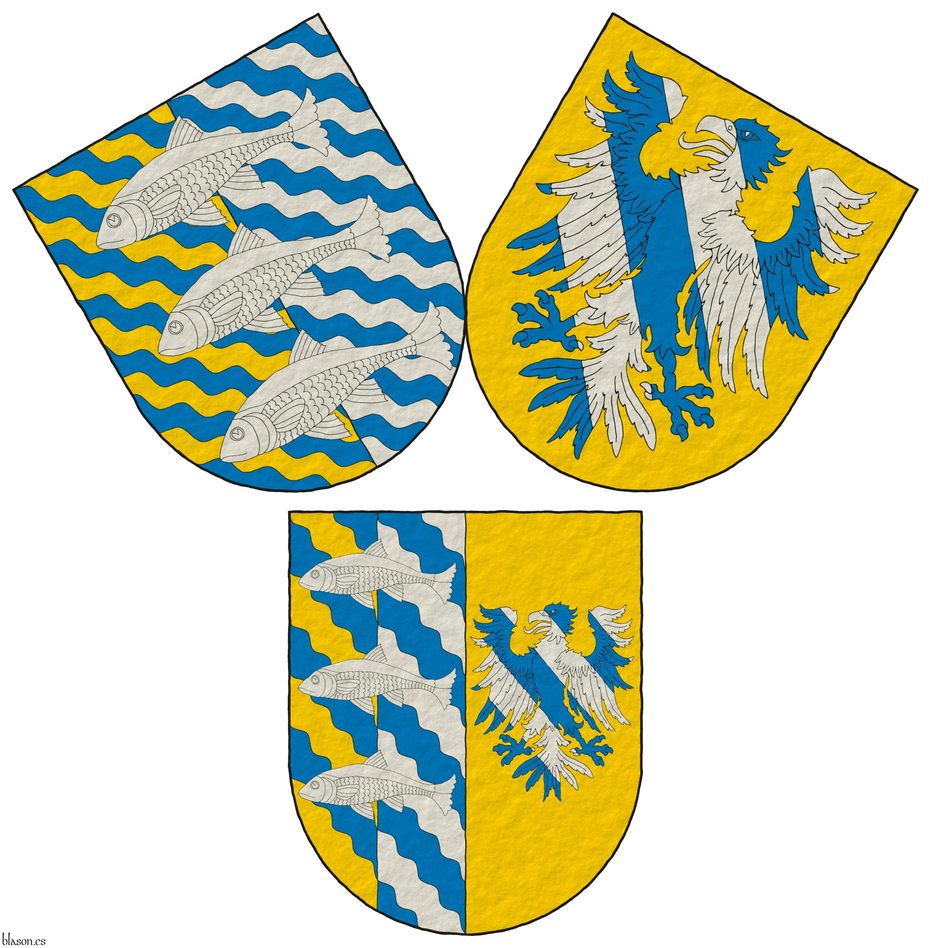Bendy


Innocent IV
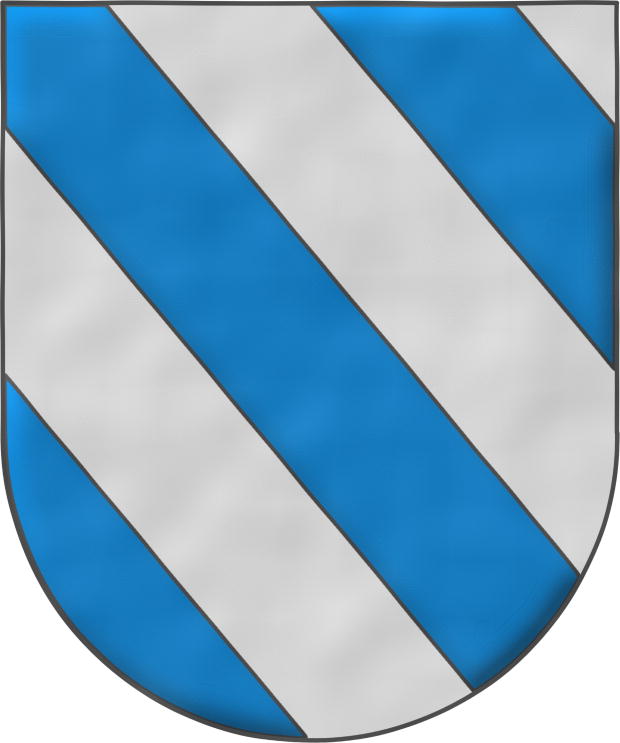
180th Pope of the Church, from 1243 to 1254. «Innocentius IV», born Sinibaldo dei Fieschi, was born in Manarola in northwest Italy.
Bendy of six Azure and Argent.
Escudo bandado de seis piezas de azur y plata.
Papal coat of arms interpreted by me with: a semicircular shield shape; a plain Argent field; bands illuminated in Azure and outlined in Sable; and the whole design with a watercolor finish.
Order of tinctures
In the bendy pattern, the tinctures are named starting from the one located at the dexter base of the shield and following an ascending sequence towards the sinister chief, although the most orthodox approach is to have only 2 tinctures, being one color and one metal.
Number of bands
It is said that it is not necessary to specify the number of bands when there are precisely 6, as in this case, and that it should be specified when there are, for example, 4 or 8. I have chosen to specify it for greater clarity of the blazon.
About the bendy pattern and the need to specify or not specify the number of its pieces, [Avilés, J.; 1725a; pages 40 and 41] and [Avilés, J.; 1780a; pages 45 and 46] say that it is «composed of four, six, or eight bends; in such a way that there are as many colors as metals, always specifying the number four and eight bands when blazoning, and not the one composed of six, as it is understood thus, without declaring the number of pieces» and without agreeing with it, and by its wording I believe that he is not entirely in agreement either, he adds «the reason that may exist for not specifying the number of six bends (although the authors do not express it) is that as the bend is one-third of the shield; and having six pieces, or six bends, the resulting number is doubled, as if the three parts were divided, which implies that the shield is filled with three bends; and taking the denomination of the figure infers, that the bendy is of six pieces: which does not happen with this equality in those of four and eight, requiring other proportions and consequently it becomes necessary to specify their number», therefore, note that the bendy of 6 does not follow the proportions of the bend, nor do those of 4 or 8, the only differential property of the one of 6 is being a multiple of 3, being 1/3 the width of the bend.
Blazon keywords: Without divisions, Bendy, Six, Azure and Argent.
Style keywords: Semi-circular, Illuminated, Outlined in sable and Watercolor.
Classification: Interpreted, Religious and Papal States.
Bearer: Innocent IV.


Adrian V
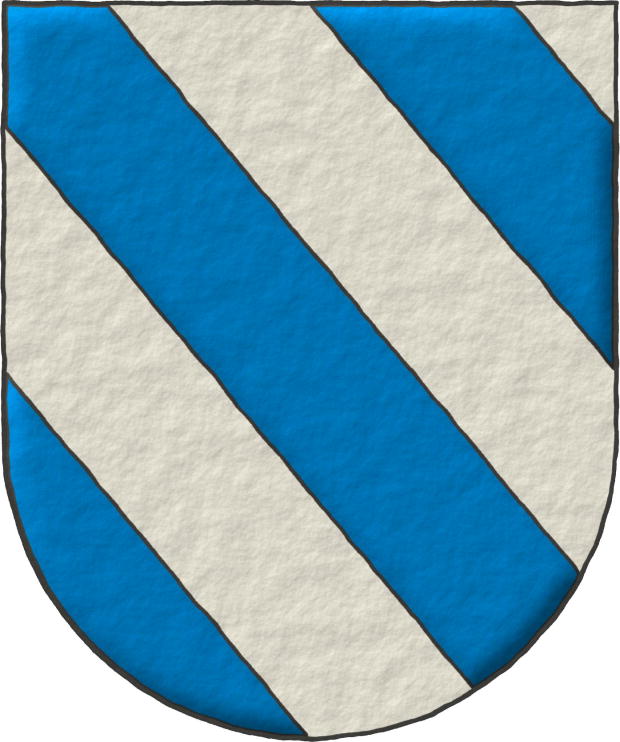
186th Pope of the Church, only 40 days in 1276. «Hadrianus V», born Ottobuono de Fieschi, was born in Genoa.
Bendy of six Azure and Argent.
Escudo bandado de seis piezas de azur y plata.
Papal coat of arms interpreted by me with: a shield with a rounded arch top; the field in plain tincture of Argent; the bands illuminated in Azure and outlined in Sable; and the whole in an elevated line style.
The blazon in French is «Bandé d'azur et d'argent de six pièces».
The banding is defined in [Avilés, J.; 1725a; page 40] and [Avilés, J.; 1780a; page 45] as the shields and also, the chiefs, fesses, pales, and figures, such as animals, etc., that are «covered and filled with bands in equal number, with as many of metal as of color».
Blazon keywords: Without divisions, Bendy, Six, Azure and Argent.
Style keywords: Semi-circular, Illuminated, Outlined in sable and Freehand.
Classification: Interpreted, Religious and Papal States.
Bearer: Adrian V.


Pius V
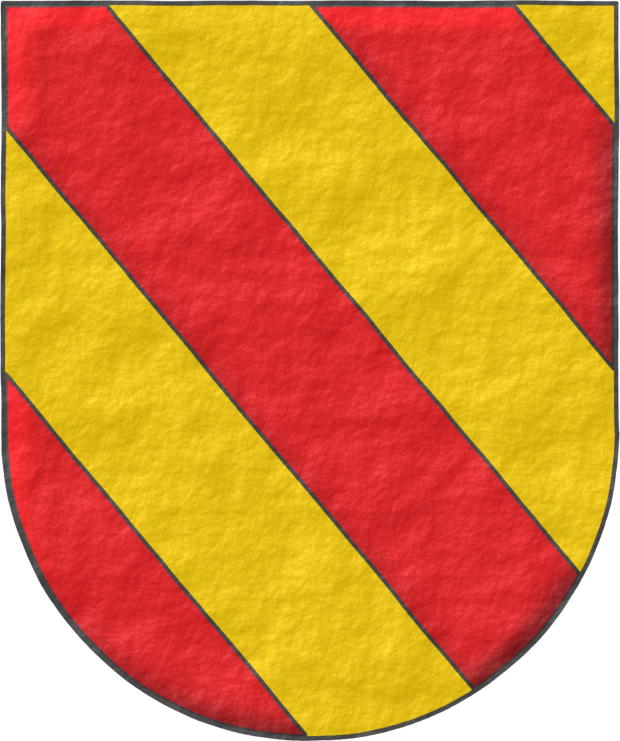
225th Pope of the Church, from 1566 to 1572. «Pius V», named Antonio Michele Ghislieri, was canonized in 1712.
Bendy of six Gules and Or.
Escudo bandado de seis piezas de gules y oro.
Papal coat of arms interpreted with: a rounded mouth; the field in flat tincture of Or; the bands outlined in Sable and illuminated in Gules; and the whole with a rough finish.
I have also seen this coat of arms described as «a shield banded of six pieces of Or and Gules».
Blazon keywords: Without divisions, Bendy, Six, Gules and Or.
Style keywords: Semi-circular, Illuminated, Outlined in sable and Rough.
Classification: Interpreted, Religious and Papal States.
Bearer: Pius V.


Clement XII
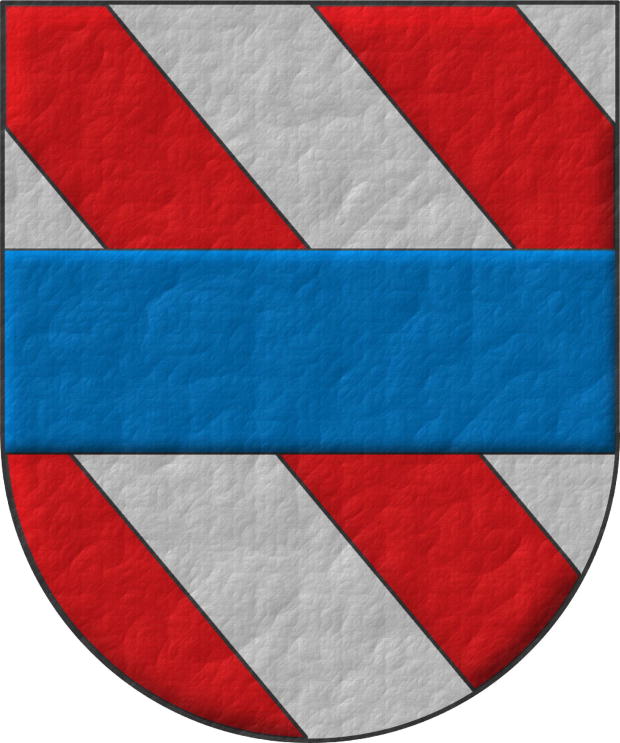
246th Pope of the Church, from 1730 to 1740. «Clemens XII», named Lorenzo Corsini, born in Florence and rests in St. John Lateran.
Bendy of six Gules and Argent; over all a fess Azure.
Escudo bandado de seis piezas de gules y plata; brochante sobre el todo una faja de azur.
Papal coat of arms interpreted with: a rounded mouth; the field in flat tincture of Argent; the fess and the bands outlined in Sable and illuminated in Gules and Azure; and the whole with a textured finish.
All are ordinaries, including the three bands and the fess, and since the blazon specifies that the fess is overall on the bands, therefore, it is not the Gules bands that are overall on the Azure fess, and they should be painted underneath.
Blazon keywords: Without divisions, Bendy, Six, Gules, Argent, Surmounted, Overall (deprecated), One, Fess and Azure.
Style keywords: Semi-circular, Illuminated, Outlined in sable and Freehand.
Classification: Interpreted, Religious and Papal States.
Bearer: Clement XII.


María Dolores Escutia Sánchez, outlined

Or, an eagle displayed bendy Azure and Argent.
Coat of arms of María Dolores Escutia Sánchez designed by Juan Lanzagorta Vallín and outlined by me.
Blazon keywords: Or, Azure, Argent, One, Eagle, Displayed and Bendy.
Style keywords: Outlined, Outlined in sable and Semi-circular.
Classification: Personal, Interpreted, Boa and Coat of arms.
Bearer: Escutia Sánchez, María Dolores.


Escutia Sánchez, María Dolores

Or, an eagle displayed bendy Azure and Argent.
Escudo de oro, un águila bandada de azur y plata.
Coat of arms interpreted by me, highlighted with lights and shadows, contoured in Sable, with a semi-circular outer contour and with a freehand finishing.
Coat of arms of María Dolores Escutia Sánchez designed by Juan Lanzagorta Vallín and emblazoned by me.
Blazon keywords: Or, Azure, Argent, One, Eagle, Displayed and Bendy.
Style keywords: Outlined in sable, Illuminated, Semi-circular and Freehand.
Classification: Personal, Interpreted, Boa and Coat of arms.
Bearer: Escutia Sánchez, María Dolores.


Juan Lanzagorta Aras, outlined

Party per pale bendy wavy Azure and Or and bendy wavy Azure and Argent, overall three fish naiant in pale Argent.
Coat of arms of Juan Lanzagorta Aras designed by Juan Lanzagorta Vallín and outlined by me.
Blazon keywords: Azure, Or, Argent, Three, Party per pale, Bendy, Wavy, Overall, Fish, Naiant and In pale.
Style keywords: Outlined, Outlined in sable and Semi-circular.
Classification: Personal, Interpreted, Boa and Coat of arms.
Bearer: Lanzagorta Aras, Juan.


Juan Lanzagorta Aras, plain tincture
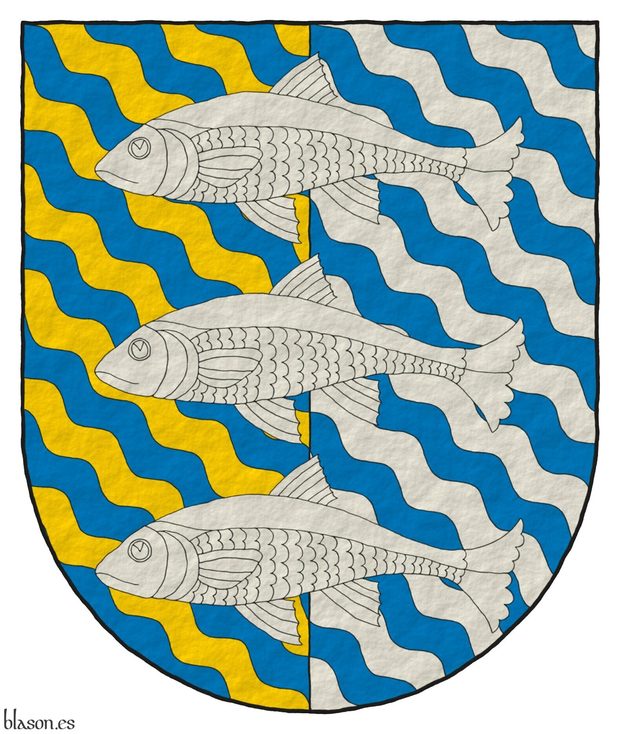
Party per pale bendy wavy Azure and Or and bendy wavy Azure and Argent, overall three fish naiant in pale Argent.
Arms painted by me, in plain tinctures, contoured in Sable, with a semi-circular external shape and with a texturized finishing.
Coat of arms of Juan Lanzagorta Aras designed by Juan Lanzagorta Vallín and emblazoned by me. Note that the second quarter begins and ends in Argent; therefore, while the first quarter is properly bendy, having an even number of bands and beginning in Or and ending in Azure, the second is not, as it has an odd number. It is almost impossible to align both quarters so that the wavy bands continue seamlessly from one to the other. Heraldically, such continuity is not required, but artistically it makes much more sense. For this reason, in this case, I chose to prioritize the artistic criterion of continuity, even if the second quarter ends with a small strip of Argent instead of finishing in Azure.
Blazon keywords: Azure, Or, Argent, Three, Party per pale, Bendy, Wavy, Overall, Fish, Naiant and In pale.
Style keywords: Outlined in sable, Plain tincture and Semi-circular.
Classification: Personal, Interpreted, Boa and Coat of arms.
Bearer: Lanzagorta Aras, Juan.


Juan Lanzagorta Aras impaled with María Dolores Escutia Sánchez
Party per pale: 1 party per pale bendy wavy Azure and Or and bendy wavy Azure and Argent, overall three fish naiant in pale Argent; 2 Or, an eagle displayed bendy Azure and Argent.
This is the coat of arms of the marriage Lanzagorta-Escutia, designed by Juan Lanzagorta Vallín and emblazoned by me. This image shows how this coat of arms is composed with the arms of Juan Lanzagorta Aras impaled with those of María Dolores Escutia Sánchez; in the top row the personal arms are shown and at the bottom the impaled arms as the result.
Blazon keywords: Azure, Or, Argent, Three, One, Party per pale, Bendy, Wavy, Overall, Fish, Naiant, In pale, Eagle and Displayed.
Style keywords: Outlined in sable and Plain tincture.
Classification: Personal, Interpreted, Schema, Boa, Coat of arms and Accolé arms.
Bearer: Lanzagorta-Escutia, marriage.


Lanzagorta-Escutia, marriage

Party per pale: 1 party per pale bendy wavy Azure and Or and bendy wavy Azure and Argent, overall three fish naiant in pale Argent; 2 Or, an eagle displayed bendy Azure and Argent.
Escudo partido: 1 partido: 1o bandado ondado de azur y oro; 2o bandado ondado de azur y plata, brochante sobre el todo tres peces nadantes en palo de plata; 2o de oro, un águila bandada de azur y plata.
Coat of arms depicted by me, in plain tinctures, contoured in Sable, and with a texturized finishing.
This is the coat of arms of the marriage Lanzagorta-Escutia, designed by Juan Lanzagorta Vallín and emblazoned by me. They are the married couple composed of Juan Lanzagorta Aras and María Dolores Escutia Sánchez. It is composed of the arms of Juan Lanzagorta Aras impaled with those of María Dolores Escutia Sánchez.
Blazon keywords: Azure, Or, Argent, Three, One, Party per pale, Bendy, Wavy, Overall, Fish, Naiant, In pale, Eagle and Displayed.
Style keywords: Outlined in sable and Plain tincture.
Classification: Personal, Interpreted, Boa and Coat of arms.
Bearer: Lanzagorta-Escutia, marriage.
-
Language
-
Categories of heraldry
-
Divisions of the field
- Without divisions
- Party per pale
- Party per fess
- Party per bend
- Party per bend sinister
- Tierce
- Tierce sinister
- Tierced per fess
- Tierced per bend
- Tierced pallwise inverted
- Quarterly
- Quarterly per saltire
- Gyronny
- Party per fess, the chief per pale
- Party per pale, the sinister per fess
- Party per fess, the base per pale
- Party per pale, the dexter per fess
- Chapé
- Chaussé
- Party per chevron
- Enté en point
- Flanched
-
Metals
-
Colours
-
Furs
-
Other tinctures
-
Ordinaries and sub-ordinaries
-
Diminutives of the ordinaries
-
Other charges
-
Charges from Nature
Water, Eagle, Bald eagle, Eagle claw, Dorsal fin, Tail fin, Two hands clasped, Lark, Tree, Trunk, Rainbow, Atom, Barbel, Acorn, Bighorn sheep, Arm, Owl, Vulture, Horse, Head, Goat, Camellia, Thistle, Merino ram, Kapok tree, Stag, Doe, Crescent, Increscent, Chrysanthemum, Tail, Tail addorsed, Ermine spot, Hummingbird, Snowflake, Heart, Roe deer, Neck, Roe deers' attires, Raven, Dolphin, Diamond, Tooth, Elephant, Emerald, Starling, Mullet, Mullet of four points, Star of David, Estoile, Male figure, Fleur de lis, Flower, Cornflower, Dogwood flower, Lotus flower, Hop cone, Bluebonnet, Puffin, Ash, Rooster, Claw, Talon, Goose, Heron, Seagull, Pomegranate, Sunflower, Swallow-tail, Falcon, Leaf, Boar, Goldfinch, Laurel, Barn owl, Lion, Lioness, Lion passant, Leopard, Lion rampant guardant, Lynx, Lily, Madonna lily, Flame, Wolf, She-wolf, Parrot, Moon, Hand, Apple, Apple tree, Martlet, Wing, Two wings in vol, Covert, Blackbird, Mount, Trimount, Fly, Wrist, Elm, Olive tree, Orbital, Bear, Palm frond, Palm tree, Dove, Poplar leaf, Panther, Jaguar, Vine, Paw, Forepaw, Foot (palmiped), Foreleg, Peacock, Chest, Pelican, Pelican in her piety, Dog, Brach hound, Warren hound, Fish, Hoof, Beak, Quill, Cinquefoil, Quetzal, Branch, Sprig, Frog, Shamrock, Caboshed, Oak, Holm oak, Rose, Double rose, Savage, Serpent, Plough of Ursa Major, Sun, Sun in splendour, Ray of the sun, Lightning flash, Stem, Badger, Tyger, Linden, Wheat, Wheat spike, Bull, Tulip, Udder, Escallop and Fox.
-
Artificial charges
Halberd, Plough share, Ace of spades, Anchor, Cyclamor, Torch, Bow, Arch, Harp, Non-classic artifact, Winnowing fan, Crozier, Conductor's baton, Pair of scales, Ship, Norman ship, Beret, Grenade, Ecclesiastical cap, Arm vambraced, Knight, Chain, Covered cup, Monstrance, Bell, Bell tower, Cannon dismounted, Carbuncle, Castle, Ribbon, Clarion, Nail, Cord, Dagger, Key ward, Turret, With a turret, Armillary sphere, Sword, Federschwert, Sabre, Parchment, Scroll, Arrow, Club, Garb, Sheaf of tobacco, Scythe, Gauntlet, Axe, Buckle, Galician granary, Polish winged hussar, Church, Oil lamp, Spear, Spear's head, Fleam, Letter, Book, Open book, Closed book, Bookmark, Page, Line, Lantern, Key, Four crescents joined millsailwise, Hammer, Menorah, Mortar, Pestle, Number, Knot, Celtic Trinity knot, Water-bouget, Comb, Piano, Millstone, Millrind, Millwheel, Clay pot, Bridge, Cuffed, Hourglass, Chess rooks, Compass rose, Rosette of acanthus leaves, Mullet of six points pierced, Broken, Portcullis, Wheel, Wagon-wheel, Symbol, Sackbut, Drum, Geometric solid, Tetrahedron, Tower, Trident, Trumpet, Double vajra and Anvil.
-
Immaterial charges
Angel, Archangel, Heart enflamed, Sacred Heart of Jesus, Paschal lamb, Dragon, Wyvern, Phoenix, Garuda, Griffin, Sea-griffin, Winged hand, Our Lady of Mercy, Pegasus, Saint George, Mermaid, Trinity, Triton, Golden fleece, Unicorn and Ouroboros.
-
External elements
-
Heraldic creations
-
References
-
Formats
-
Keywords on this page
Watercolor, Adrian V, Azure, Bendy, Boa, Surmounted, Overall, Clement XII, Outlined, Outlined in sable, Displayed, In pale, Coat of arms, Accolé arms, Escutia Sánchez, María Dolores, Schema, Papal States, Fess, Personal, Gules, Illuminated, Innocent IV, Interpreted, Lanzagorta Aras, Juan, Lanzagorta-Escutia, marriage, Semi-circular, Naiant, Wavy, Or, Party per pale, Fish, Pius V, Argent, Without divisions, Religious, Rough, Six, Overall (deprecated), Plain tincture, Freehand, Three, One and Eagle.
